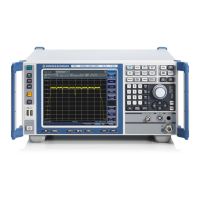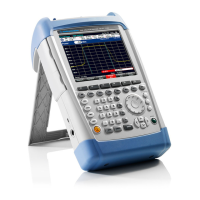Remote Control
R&S
®
FSVA/FSV
592Operating Manual 1176.7510.02 ─ 09
Bit No. Meaning
6 MSS bit (master status summary bit)
The bit is set if the instrument triggers a service request. This is the case if one of the other bits
of this registers is set together with its mask bit in the service request enable register SRE.
7 STATus:OPERation status register summary bit
The bit is set if an EVENt bit is set in the OPERation status register and the associated
ENABle bit is set to 1. A set bit indicates that the instrument is just performing an action. The
type of action can be determined by querying the STATus:OPERation status register.
IST Flag and Parallel Poll Enable Register (PPE)
As with the SRQ, the IST flag combines the entire status information in a single bit. It
can be read by means of a parallel poll (see "Parallel Poll" on page 600) or using the
command *IST?.
The parallel poll enable register (PPE) determines which bits of the STB contribute to
the IST flag. The bits of the STB are "ANDed" with the corresponding bits of the PPE,
with bit 6 being used as well in contrast to the SRE. The IST flag results from the
"ORing" of all results. The PPE can be set using commands *PRE and read using com-
mand *PRE?.
Event Status Register (ESR) and Event Status Enable Register (ESE)
The Event Status Register (ESR) is the source for the registers on the highest levels
and is similar to the EVENt part of a SCPI register. It is defined by IEEE 488.2. You
can read out the ESR with *ESR?.
The corresponding ENABle part of the ESR is the Event Status Enable mask register
(ESE). The ESE is directly linked to the ESR. You can control the ESE with *ESE.
Table 4-4: Meaning of the bits used in the event status register
Bit No. Meaning
0 Operation Complete
This bit is set on receipt of the command *OPC exactly when all previous commands have been
executed.
1 Unused
2 Query Error
This bit is set if either the controller wants to read data from the instrument without having sent a
query, or if it does not fetch requested data and sends new instructions to the instrument
instead. The cause is often a query which is faulty and hence cannot be executed.
3 Device-dependent Error
This bit is set if a device-dependent error occurs.
The R&S FSVA/FSV adds a number to the error queue. The number is either in the range
between -300 and -399 or greater than 0. If the number is positive, it indicates the error type in
greater detail.
4 Execution Error
This bit is set if a received command is syntactically correct but cannot be performed for other
reasons. An error message with a number between -200 and -300, which denotes the error in
greater detail, is entered into the error queue.
Remote Control - Basics

